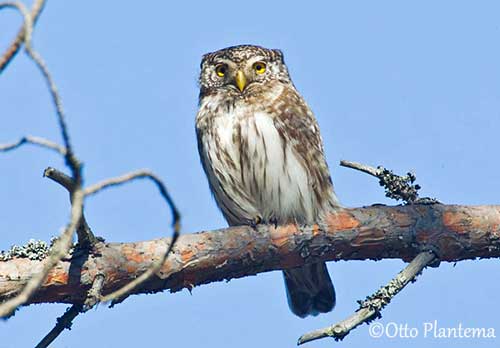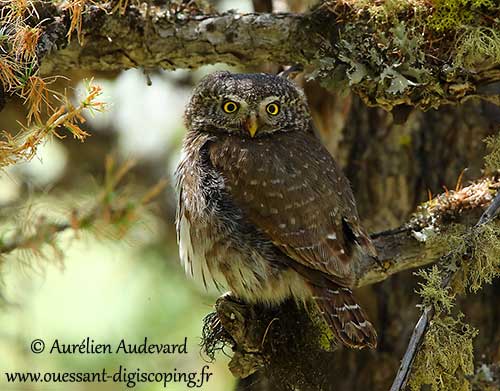
Fr: Chevêchette d’Europe
Ang: Eurasian Pygmy Owl
All: Sperlingskauz
Esp: Mochuelo Alpino
Ita: Civetta nana
Nd: Dwerguil
Sd: sparvuggla
Photographers:
Aurélien Audevard
OUESSANT DIGISCOPING
Otto Plantema
Trips around the world
Ingo Waschkies
Bird Photography
Text by Nicole Bouglouan
Sources:
HANDBOOK OF THE BIRDS OF THE WORLD Vol 5 by Josep del Hoyo-Andrew Elliott-Jordi Sargatal - Lynx Edicions - ISBN: 8487334253
THE HANDBOOK OF BIRD IDENTIFICATION FOR EUROPE AND THE WESTERN PALEARCTIC by Mark Beaman, Steve Madge - C. Helm - ISBN: 0713639601
OWLS OF THE WORLD – By Claus König, Friedhelm Weick and Jan-Hendrik Becking - IBSN 978-0-7136-6548-2
EOL – Encyclopedia of Life – Glaucidium passerinum
Wikipedia, the free encyclopaedia
Eurasian Pygmy Owl
Glaucidium passerinum
Strigiformes Order – Strigidae Family
INTRODUCTION:
The Eurasian Pygmy Owl is a tiny owl, the smallest owl in Europe. This species is sedentary and remains in the boreal forests from N and C Europe to Siberia. It typically nests in tree cavities or nest boxes, and often uses the same nesting territory during several following years. It is mostly crepuscular, and can be seen during the hours near sunrise and sunset.
The Eurasian Pygmy Owl has a wide range and its population is currently stable.
DESCRIPTION OF THE BIRD:
Biometrics:
Length: 16-17 cm
Wingspan: 34-36 cm
Weight: M: 50-65 g – F: 67-77 g
The Eurasian Pygmy Owl has dark rufous-brown to greyish-brown upperparts, with buffy-white spots overall. On the upperwing, the flight-feathers are dark brown with narrow, buffy-white bars. The tail is dark brown with about five narrow whitish bars.
The underparts are mostly white. We can see a brown barring on breast sides and flanks, and brown streaks from throat to belly. The underwing-coverts are white and contrast with the dark barred flight-feathers.
On the rounded head, the facial disk is indistinct, pale greyish-brown, with several darker concentric lines formed by small dark spots. The short eyebrows and the lores are whitish. The crown is finely spotted whitish.
Two large, blackish spots surrounded by whitish can be seen on the nape, like eye-like marks.
The bill is yellowish-horn with grey cere. The eyes are yellow. On the legs, tarsi and base of yellowish toes are feathered whitish to brownish-white.

Male and female are similar but the female is slightly larger than male.
This species has brown and grey morphs and varying markings. The brown morph occurs in most of range, whereas the grey morph is visible only in C and E Siberia.
The juvenile resembles adult, but it has darker head, upperparts and wing-coverts, with indistinct pale spotting. The facial disk is darker. The upperbreast is uniformly dark, lower breast and flanks lack the dark barring. The underparts show less distinct dark streaks.
The immature lacks the eye-like markings and is slightly paler with indistinct barring across the breast. The upperparts are warmer-toned and the crown shows only small buff speckles.
SUBSPECIES AND RANGE:
The Eurasian Pygmy Owl has two subspecies.
G.p. passerinum is found in Scandinavia and mountains of S, C and E Europe, E across NW and C Russia to C Siberia (upper R Yenisey).
G.p. orientale occurs in C and E Siberia to Sakhalin and NE China. This race is paler above with pure white, sharply defined spots. Breast and flanks are more strongly marked brown.
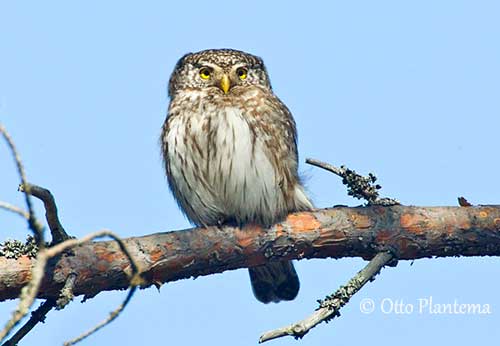
HABITAT:
The Eurasian Pygmy Owl frequents coniferous forest of boreal zone (taiga), and coniferous and mixed montane forest in higher mountains, from 500 to 800 metres of elevation.
It favours habitats with mature trees, clearings, dense patches of young spruces while hunting. During winter, it may frequent broadleaved woodland, farms or gardens.
The nesting sites are often close to swampy areas with small ponds, creeks with open water, and patches of young spruces in close vicinity.
CALLS AND SONGS: SOUNDS BY XENO-CANTO
The Eurasian Pygmy Owl gives advertising call at dawn and dusk. This call can sometimes be heard during the day, but rarely at night. It is a soft, but far-carrying sound, a repeated fluting whistle “hyew” or “hyewk”. The female’s call is more nasal “hyeelk”.
When the bird is excited, this call is interspersed with shorter, lower-pitched, vibrating hoots “hyew…huhuhu…hyew…huhuhu…hyew…”
When both mates establish the territory in autumn, they give series of shrill, fluty notes “cheek-cheek-cheek-cheek-cheek” rising in pitch and speed.
Female and young give begging calls, some “tseeeeeh” descending towards the end.
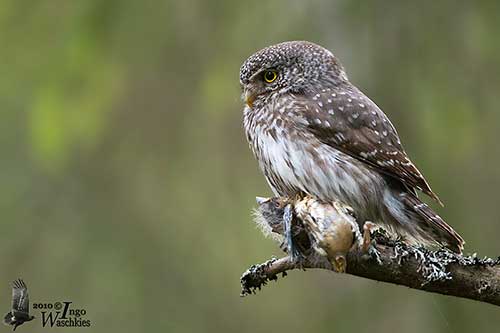
BEHAVIOUR IN THE WILD:
The Eurasian Pygmy Owl feeds mainly on small vertebrates including mammals (voles, mice and shrews), and small birds such as Hawfinch, young Turdidae and Red Crossbill. It also takes reptiles such as lizards and small snakes, and some insects, but rarely.
This species is known for storing surplus-food in tree holes, nest-boxes… that can be used to survive in winter. During the breeding season, the food is stored near the nest.
It hunts from a perch, watching for some time, bowing forwards, flicking the wings and cocking the tail before to swoop down onto the prey on the ground. But the small birds are taken in dashing flight from a bush.
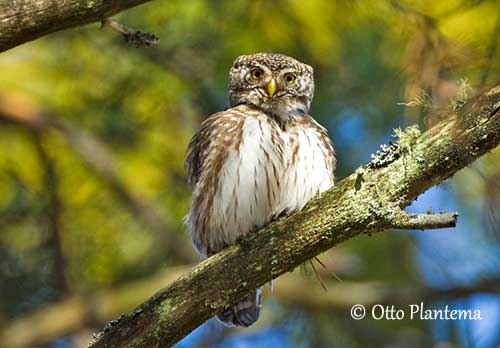
The Eurasian Pygmy Owl is monogamous, with pair-bonds lasting sometimes more than one season. The male is very territorial and usually occupies the same territory for several following years. It is usually more active against the new neighbours, whereas it shows little aggression towards its usual neighbours.
The male sings from different perches within its territory. If the pair is already formed, the female joins the male, but unpaired pairs often duet.
Once paired, the female gives “seeht” calls instead of her usual song. The male leads her around the territory, and they copulate at different places, sometimes far from their future nesting site. They visit the previous year’s hole which be used for breeding later. The male enters the hole and sings from the entrance or from inside. The female inspects the cavity. After accepting the hole, she stays near it or visits it at dusk. She is fed by the male in the vicinity of this site.
If the previous year’s nest is reused, the female cleans it and removes some debris from the last brood. Both mates copulate several times except at night.
The Eurasian Pygmy Owl often displays numerous expressive postures with cocked tail, flicking it from side to side, or raises body and head feathers when it is angry. When alarmed, it appears very slim and adopts an upright posture while the feathers are held very tight to the body. In this posture, small tufts may appear on the sides of the forecrown.
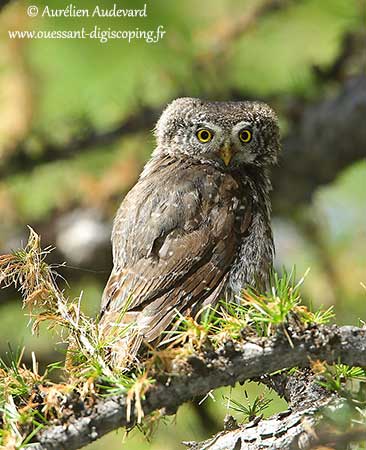
The Eurasian Pygmy Owl is mainly resident. It may perform some dispersion, especially in N of range, according to weather conditions and prey availability.
The Eurasian Pygmy Owl has undulating flight over long distances. During aggressive encounters, it glides from perch to perch on outstretched wings, or attacks with diving flights.
REPRODUCTION OF THIS SPECIES:
The breeding season takes place between April and July. The Eurasian Pygmy Owl is a cavity-nester, and uses natural cavities, abandoned woodpecker holes and nest-boxes. The hole is cleaned but the female does not add nest material.
The female lays 3-7 (or more) white eggs, usually at two days intervals. She incubates alone during 28-29 days, and starts once the last egg is laid. She is fed by the male outside the nest. The male calls her when it brings food, usually in the morning or the evening. The young hatch almost synchronously and the female broods them during 9-10 days. The male brings food and calls the female which takes the prey back into the hole and feeds the chicks.
At three weeks old, they begin to peer out of the hole. Later, the female roosts outside and enters only for feeding the young and cleaning the nest.
Pellets are accumulated at base of the nesting tree, result of indigestible parts of the prey such as hair, feathers, bones and other remains.
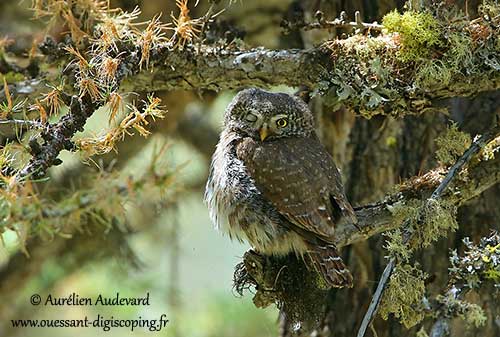
The young leave the hole at 28-34 days, and are able to fly some distance. They do not return to the nest once fledged, but they often roost close to one another in body contact. After three days, the adults lead them to another part of the territory, and they are fed by the female for about one week. Then, the female leaves them for moulting, and the male tends the young for 4-6 weeks, until they become independent. They may breed in the following spring, when 9-10 months old.
PROTECTION / THREATS / STATUS:
The Eurasian Pygmy Owl is not globally threatened and its population is currently stable. The numbers may vary depending on weather conditions and rodent availability.
Deforestation in W Germany involved the disappearance of this species from large parts of the range. The species has been reintroduced to the Black Forest. However, the German population has increased and expanded during the last decades, including in NE France.
A very preliminary estimate of the global population size is 300,000/1,500,000 individuals, but further validation is needed.
The Eurasian Pygmy Owl is currently evaluated as least Concern.
